Ancient Japanese metalworking blends technical mastery with spiritual practice. You’ll find artisans using specialized hammers and high-carbon steel heated to over 2000°F, while honoring the belief that each blade contains its own spirit. Traditional techniques like water forging and careful quenching create both functional tools and cultural artifacts. From samurai swords to culinary knives, these methods reflect centuries of wisdom passed through master-apprentice relationships. The ancient forge’s secrets await your discovery.
The Evolution of Japanese Metalworking Traditions
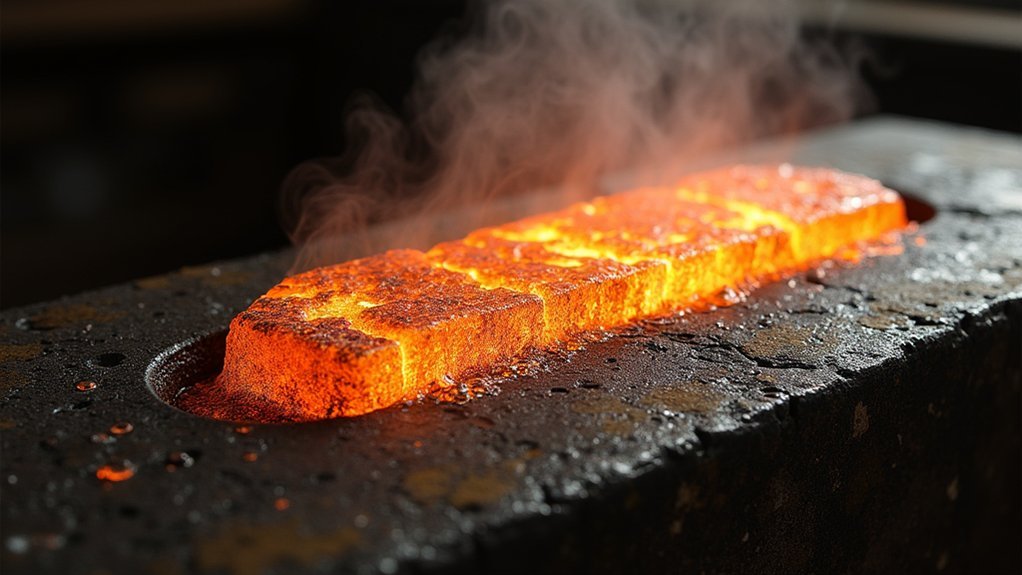
While many ancient civilizations developed metalworking independently, Japan’s unique tradition began in 583 AD with techniques imported from Korea.
These forging techniques evolved distinctively as Japan’s isolation fostered innovative adaptations to suit local needs and materials.
Japan’s geographic seclusion transformed borrowed metalworking skills into unique crafts reflecting its cultural identity and indigenous resources.
Traditional Japanese blacksmithing flourished during the samurai era, when swordsmiths perfected methods that balanced functionality with artistic expression.
The history of Japanese metalwork shows remarkable shifts—from weapons to culinary tools during the Edo period as society’s needs changed.
Sacred Origins: Metal Arts in Ancient Japan
The spiritual dimensions of metalworking in Japan reach far deeper than mere craftsmanship. When you examine Japanese metalworking history, dating back to 583 AD with Korean-influenced techniques, you’ll discover a profound reverence for the craft that transcends utilitarian purposes.
The soul of Japanese metal arts lies in the belief that each blade contains a spirit. This philosophy guided craftsmen using the Japanese tatara method—a painstaking smelting process transforming iron sand into tamahagane steel.
Traditional techniques evolved during the samurai era, with forging a blade becoming both art and spiritual practice. You can see this sacred connection in how weapons like the katana became more than tools—they embodied the smith’s dedication and skill, marking the intersection of divine craftsmanship and warrior culture.
Tools and Materials in Traditional Japanese Forging

Behind every masterful Japanese blade lies an artisan’s carefully selected arsenal of tools and materials. You’ll find high-carbon steel, particularly 1095, at the heart of traditional Japanese forging, offering the perfect balance of hardness and flexibility essential for durable, razor-sharp edges.
The soul of Japanese bladesmithing rests in its materials—where carbon steel becomes poetry through an artisan’s reverent hands.
The craftsman’s workspace centers around a robust anvil where heated metal transforms through calculated strikes from specialized hammers. Square and cross peen hammers enable diverse forging techniques, while a hacksaw performs initial cutting tasks.
During the sunobe process, metal heated to over 2000°F is meticulously shaped to form the nakago.
Safety equipment isn’t optional—gloves, aprons, and goggles protect artisans while they employ techniques like water forging, which removes scale and maintains ideal working conditions.
The Role of Fire and Water in Japanese Metal Techniques
Fire and water represent opposing yet complementary forces at the heart of Japanese metalworking, transforming raw materials into functional art.
The forging process begins with fire heating steel to 2000°-2100°F, making it malleable for shaping. Artisans vigilantly monitor flame colors to determine perfect temperatures for each stage of creation.
Water’s role becomes essential during quenching, where rapid cooling enhances the blade’s hardness and chipping resistance. This sudden shift from extreme heat to cold creates the distinctive properties that Japanese blades are renowned for.
Beyond their functional purposes, fire and water embody spiritual significance in traditional craftsmanship, symbolizing balance between contrasting elements.
The annealing process—allowing metal to cool naturally—relieves internal stresses, demonstrating how these elements work in harmony to produce exceptional, durable works.
Tamahagane: The Soul of Japanese Blades

Forged through ancient techniques dating back over a millennium, tamahagane represents the pinnacle of Japanese metallurgy and forms the literal and spiritual core of traditional Japanese swords.
You’ll find this high-carbon steel is produced in tatara furnaces through a meticulous process combining iron sand with charcoal over several days.
What makes tamahagane exceptional is its unique composition, allowing smiths to create laminated blades that marry the hardness of hagane with the flexibility of softer jigane.
Traditional forging techniques showcase the remarkable purity of tamahagane, resulting in blades that maintain exceptional sharpness while being easier to maintain than other steels.
Today’s swordsmiths honor ancestral methods while embracing modern metallurgical knowledge—preserving an art that remains virtually unchanged yet continually refined over centuries.
Pattern Welding and Folding Techniques
The artistry of tamahagane’s composition finds its full expression in Japan’s sophisticated pattern welding and folding techniques.
Tamahagane sings through Japan’s ancient folding arts, where steel becomes poetry in the hands of masters.
When you examine traditional Japanese blades, you’re witnessing the culmination of meticulous orikaeshi kitae—folding methods that eliminate impurities while creating homogeneous steel structures vital for blade integrity.
This process isn’t merely functional; each fold strategically increases carbon content in specific areas, allowing for both razor-sharp edges and remarkable durability.
You’ll notice distinctive surface patterns, particularly the celebrated “hamon” line that marks the shift between harder edge and softer spine.
Mokume-gane: The Wood Grain Metal Art
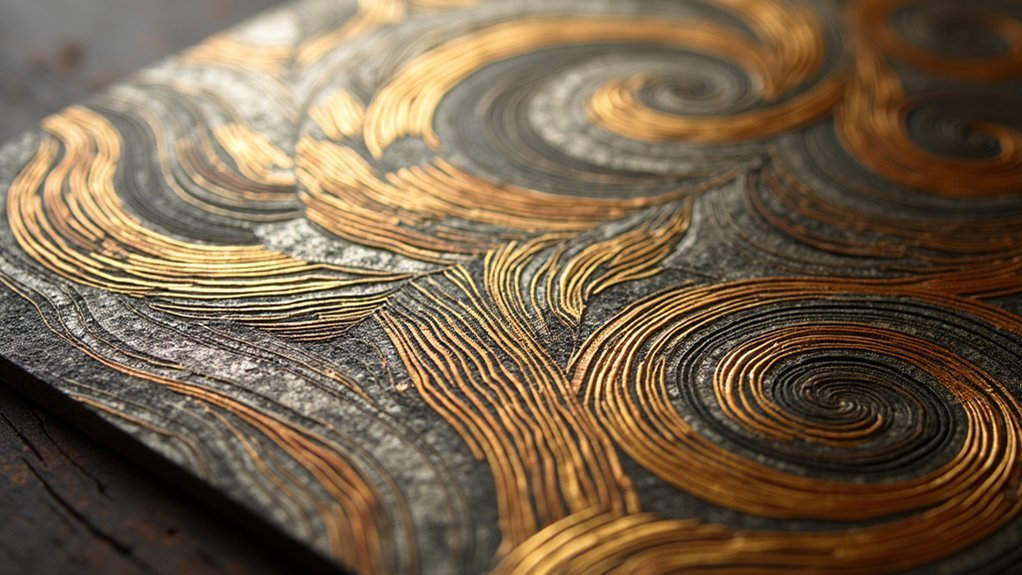
Artisans practicing mokume-gane achieve what appears impossible—metals transformed to mimic natural wood grain patterns through painstaking fusion of dissimilar metals.
This 17th-century technique begins with careful stacking of copper, silver, and gold sheets that are then bonded through controlled heating and forging that unites without fully melting the metals.
You’ll find the essence of traditional craftsmanship in how these masters manipulate the bonded metal—twisting, folding, and carving to reveal intricate designs hidden within the layers.
Originally developed to beautify samurai swords while maintaining their functionality, mokume-gane has evolved beyond weaponry.
Today, this layering metals technique graces contemporary jewelry and art pieces, bridging centuries of Japanese metalworking tradition with modern aesthetic sensibilities.
Inlay and Surface Decoration Methods
Five distinct techniques defined ancient Japanese metal decoration, with inlay processes ranking among the most visually striking. When you examine ancient Japanese metalwork, you’ll notice how artisans embedded gold or silver into metal surfaces, creating intricate patterns that told stories and signified status.
The shakudo technique transformed copper-gold alloys into deep, dark canvases that dramatically highlighted inlaid designs. You’ll find nunome’s fabric-like textures adding remarkable depth to bladed weapons and fittings, while taka-zogan’s raised gold and silver elements created dimensional contrast against base metals.
These surface decoration methods weren’t merely aesthetic choices—they reflected the owner’s identity and social position. Each inlay technique represented the culmination of centuries of refined craftsmanship, where ancient techniques merged artistic expression with technical precision in metal arts.
Edo Period Innovations in Metal Craftsmanship
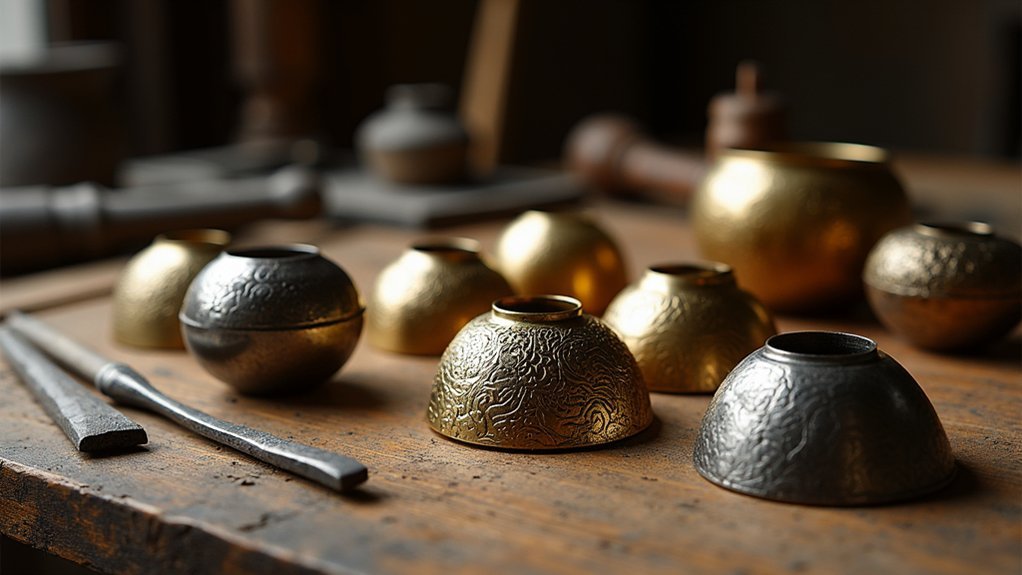
During Japan’s Edo period, metalworking underwent a profound transformation as swords gave way to culinary implements in response to shifting societal demands.
Master craftsmen adapted their sword making techniques to create specialized kitchen knives like Gyuto and Santoku, revolutionizing both form and function.
You’ll find the uchihamono technique exemplifies this evolution, where artisans layered hard hagane and soft jigane steels to achieve unparalleled sharpness.
This meticulous heat treatment process produced blades that maintained their edge while resisting breakage.
Each knife shape was thoughtfully designed for specific culinary tasks, merging practicality with aesthetic beauty.
Despite increasing mechanization, these blacksmiths preserved handcrafted traditions, infusing each piece with distinctive character.
Their innovative approaches to metalworking established standards of excellence that continue to influence Japanese cutlery today.
Master-Apprentice Relationships in Japanese Forges
At the heart of Japanese metalworking excellence lies the shokunin system, where knowledge flows through generations via intimate master-apprentice bonds.
You’ll find apprentices beginning their journey at tender ages, first managing forge maintenance before touching the sacred tools of their craft.
This master-apprentice relationship transcends mere technical instruction—it’s a holistic transfer of philosophy, character, and dedication.
Masters don’t simply teach hammering techniques; they instill reverence for materials and patience in craftsmanship.
The ritualized transmission of traditional techniques creates profound loyalty between master and student.
As an apprentice, you’ll spend years observing, absorbing, and practicing under watchful eyes before earning the right to create independently.
This sacred relationship guarantees Japanese metalworking survives not just as technical skill but as cultural heritage, preserving centuries-old wisdom through living practice.
Spiritual Aspects of Traditional Metal Forging
Japanese metal forging transcends mere craftsmanship as it weaves profound spiritual dimensions into every hammer strike and fold. When you observe a smith at work, you’re witnessing a meditative practice connecting them to elemental forces—fire, earth, and water working in harmony.
Craftsmen believe each blade possesses a unique soul. Before beginning their work, many smiths perform rituals and prayers, invoking ancestral guidance to honor both tradition and artistry.
The blade awaits its awakening, dormant until ancestral spirits guide the smith’s hands through sacred ritual.
The creation of a katana exemplifies this spiritual journey, embodying not just technical expertise but philosophical ideals of balance. The concept of “Mizukagami” (water mirror) captures this essence perfectly—your blade’s quality directly reflects your spiritual purity and intention.
In Japanese spirituality, the rhythmic dialogue between hammer and metal isn’t just craftsmanship; it’s communion with something greater.
Preservation of Ancient Japanese Metalworking Knowledge
While traditional Japanese metalworking faces modern production pressures, dedicated artisans continue safeguarding ancient techniques through meticulous documentation and apprenticeship systems.
Workshops like Yaegashi Uchihamono Seisakusho exemplify this preservation, maintaining Edo-period forging methods that fourth-generation blacksmith Master Yaegashi Muneaki practices today.
You’ll find the uchihamono technique’s genius in combining hard hagane steel with soft jigane iron—creating blades of exceptional quality and durability.
The wakashi-yaki and yaki-ire processes highlight Japanese metalworkers’ intricate understanding of materials, emphasizing manual hammering over machinery.
Their belief that each handcrafted knife embodies the maker’s spirit guarantees these techniques remain alive.
When you hold these blades, you’re connecting with centuries of knowledge preserved through generations of dedicated craftsmen.
Frequently Asked Questions
What Is the Japanese Metal Folding Technique Called?
You’re asking about Japanese metal folding. It’s called “orikaeshi kitae” (折り返し鍛え). You’ll find this technique creates stronger steel by repeatedly folding and hammering the metal, reducing impurities and distributing carbon content evenly.
Who Is the Best Japanese Swordsmith Today?
You’ll often hear Yoshindo Yoshihara named as the best Japanese swordsmith today. He’s a Living National Treasure. Hideo Matsumoto and Masayuki Kato are also highly respected for their exceptional craftsmanship and innovative approaches.
Who Was the Greatest Japanese Blacksmith?
You’d find most historians consider Masamune the greatest Japanese blacksmith. He’s celebrated for his 13th-century katanas with unmatched sharpness and beauty. His divine craftsmanship established standards still revered today.
How Hard Is It to Forge a Katana?
Forging a katana is extremely difficult. You’ll need years of training to master the precise temperature control, specialized folding techniques, and meticulous polishing methods required to create a properly balanced, sharp, and durable blade.
In Summary
As you’ve discovered, Japan’s ancient metal arts aren’t just historical techniques—they’re living traditions. You’ll find their essence in every hammer strike, fold, and quench. By understanding these methods, you’re connecting to centuries of craftsmanship that’s survived through dedicated master-apprentice relationships. Today’s artisans don’t just preserve these skills; they’re ensuring you’ll experience this remarkable cultural heritage for generations to come.


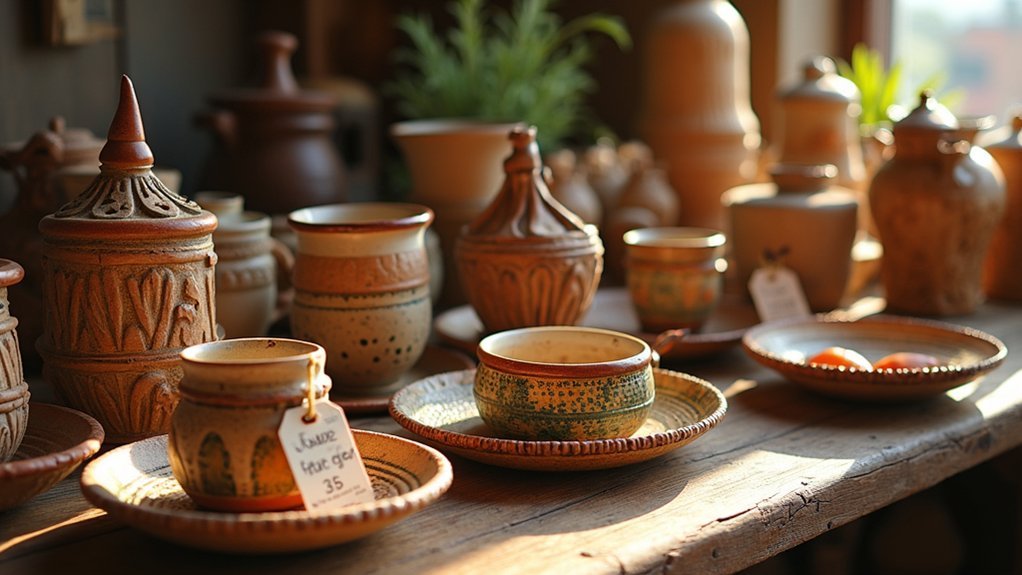
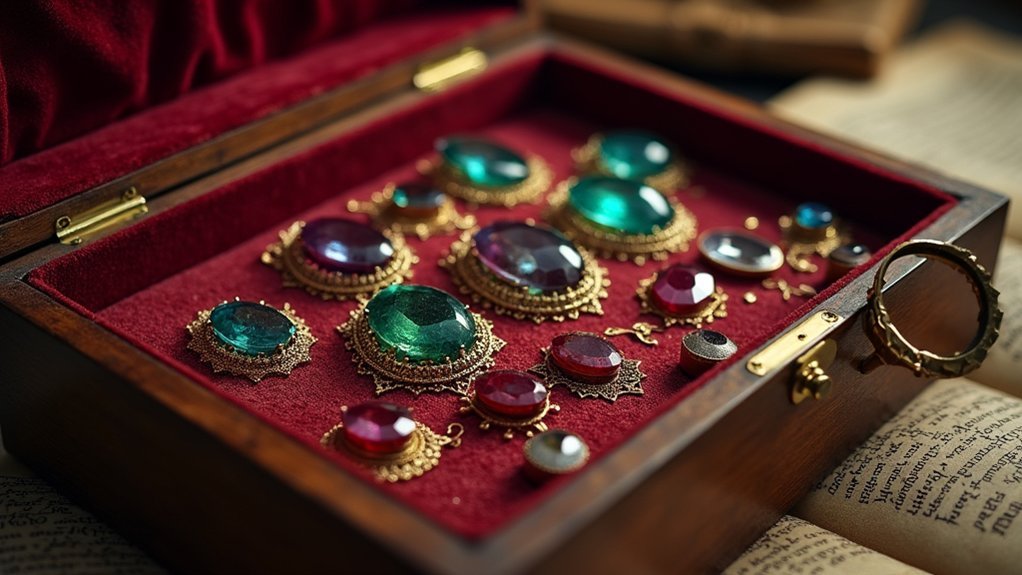
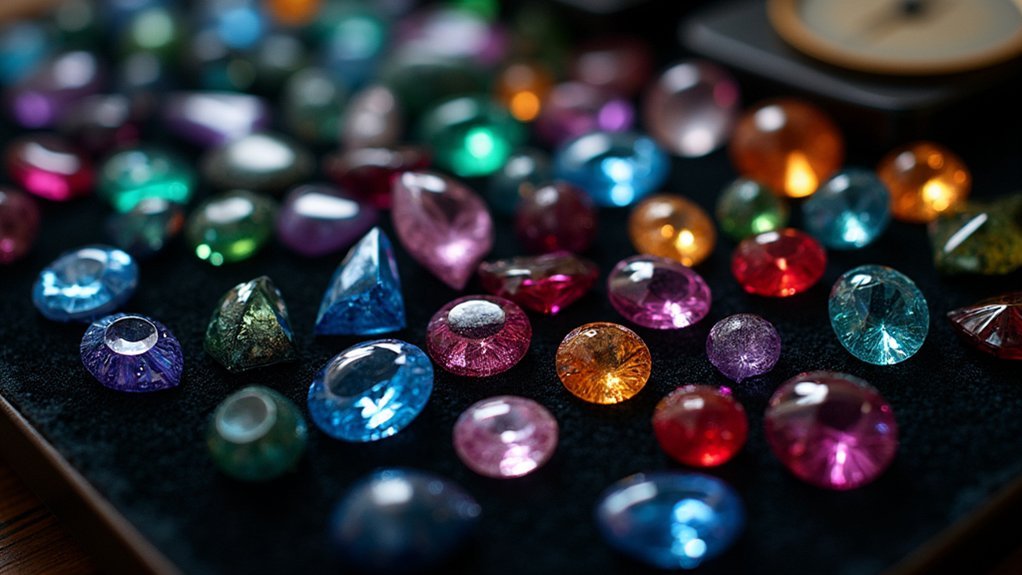
Leave a Reply